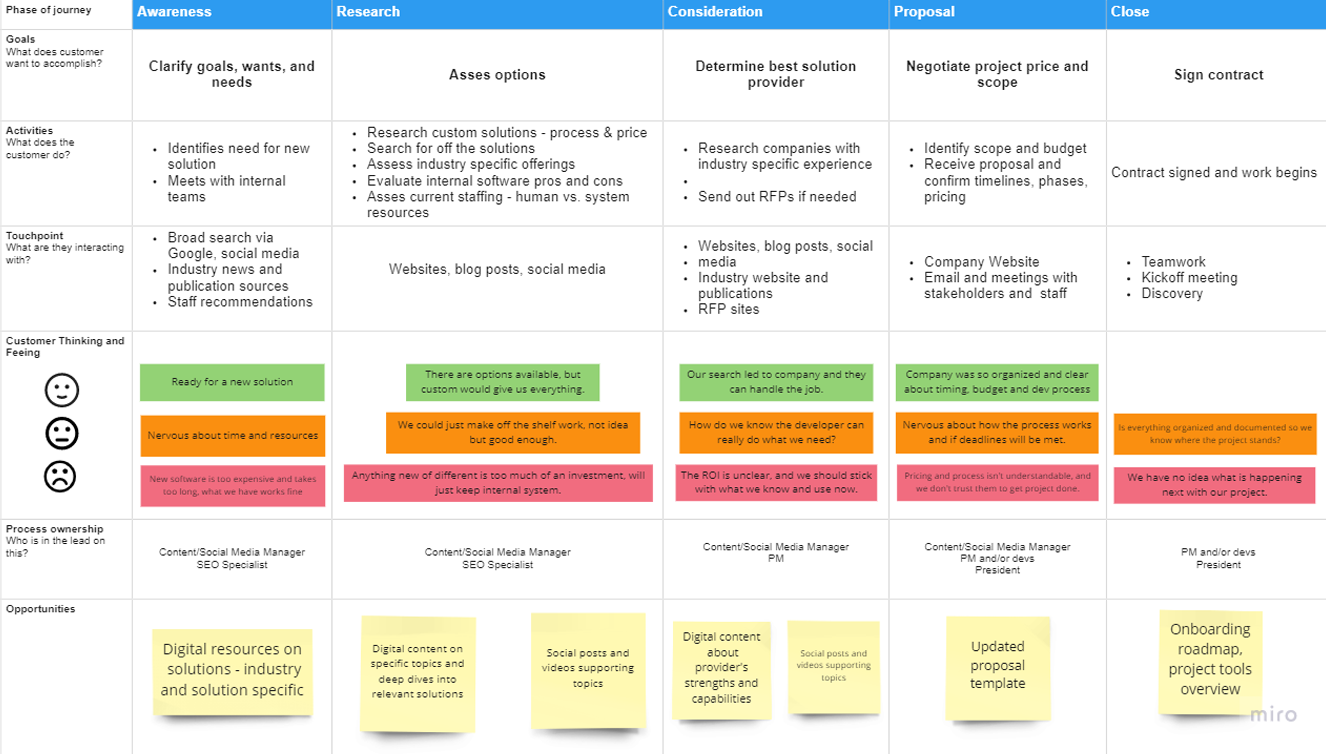When starting a new web project for your business, it’s easy to focus on the way you want the website to look and fail to give adequate thought to your users. The user is the most important part of any web development project. Your web app or site can have the most beautiful design and function, but if the user's experience isn't great, then all that hard work is for nothing.
Before diving into design and development, you need to have a plan in place for exactly how the user experience should flow. You need to step into the shoes of a user and see the app from their perspective. A great way to get insights about this is to create user journey maps.
What is a user journey map?
A user journey map is a graphic representation of what a user feels/does as they interact with your web app or site. It involves mapping out various steps that a user would go through as they interact with your product. This is done from the first moment they see your product to when they become repeat users or leave it entirely. The idea is to map out every possible action that a user might take to get better insight into how they are likely to interact with your product.
The user journey map analyzes the users' digital footprints. It traces their actions and the reasons behind their actions to get a better perspective on making the design more user-centric. In addition, it helps detail the user journey from onboarding to conversion and beyond.
Do you really need a customer journey map?
Any company can use a customer journey map to improve the customer experience and increase user loyalty. A user journey map can help multiple departments—marketing, sales, product, and customer service—optimize their processes in various ways. Some of the advantages of mapping your user's journey are as follows:
- Promote a customer-centric culture both internally and externally.
- Examine customer motivations to learn more about your target market and generate revenue.
- Boost sales conversion rates without effort.
- Gain a better understanding of your customers' needs to improve the customer experience.
- Reduce customer support tickets by identifying customer pain points.
- Increase repeat business.
- Reduce customer churn and increase the customer lifetime value.
- Support marketing campaigns.
Characteristics of customer journey maps
A typical customer journey map includes:
Customer personas
A customer persona is a profile of your ideal customer based on existing customer data and market research. For example, buyer personas make the ideal customer you're trying to attract more human, allowing you to understand them better and choose the best marketing strategy to convert them.
A customer persona is a fictionalized version of your ideal customer conducting research. You can have multiple customer personas for your business, and knowing this buyer helps you deliver a positive customer experience. This buyer will become one of your customers.
The following elements make up your customer persona:
- Personal, professional, and specific demographics (age, gender, location, education, income, marital status, skills, routines, etc.).
- Personal and professional objectives, priorities, and challenges.
- Personal and professional values and what products and companies are essential to them.
- Preferences, such as the content they consume, communication methods, communities, groups, or associations, and how they spend their time online and off.

User Journey phases
Journey phases refer to the various high-level stages in the customer roadmap. The rest of the information in your user journey map is organized by them. Phases include thoughts, emotions, and actions.
The stages will differ depending on the scenario, and most organizations will have data to help them determine what these phases are for a given scenario. For example, you'll see awareness, research, evaluation, and decision-making a lot in the customer phases.
Pain Points
A pain point is a specific industry issue that your company's customers or potential customers are experiencing. Scenarios can be based on real time scenarios (for existing products and services) or hypothetical (for future products and services) (for products in the design stage).
Actions, mindset, and sentiment
As a result of their mindset, each customer takes a specific action, which they will express in their own sentiment.
- Actions: When a customer interacts with your brand to achieve a specific goal.
- Mindset: Respond to users' thoughts, questions, motivations, and information needs at various journey stages.
- Sentiment: customers' feelings about your brand, whether they think it's good, bad, or indifferent. Indicate the emotional highs and lows by plotting these emotions in a single line across the journey phases.
Opportunities
The opportunities in a customer journey map are the desired outcomes. The key components of maps should vary depending on the goal of the journey-mapping initiative.
Opportunities can also be gleaned from mapping; they speak to ways to improve the user experience.
Identify personas, map the triggers that lead to desired outcomes, and discuss opportunities to create a customer journey map.
Create a customer journey map, identify personas, map triggers that lead to desired outcomes, and talk about opportunities.
What are customer journey touchpoints?
Touchpoints in the customer journey are discrete interactions between customers and companies.
There are numerous touchpoints in the customer journey for brands; here are a few examples:
- Social media posts
- Blog posts
- Product demos
- Live chats
- Advertisements
- Brick and mortar visits
- Website visits
Returning customer touchpoints, such as how engaged they are with your product, if they return to your website, or if they attend your events for the second or third time, must all be considered.
Examples of customer touchpoints
Each touchpoint must be identified in order to create a customer journey map that will result in a better customer experience. Make a list of potential customer actions for each touchpoint after you've identified them.
Customer touchpoints can lead to the following actions:
- Submitting a contact form
- Following you on social media
- Requesting a demo or a phone call
- Subscribing to your blog
- Clicking a paid ad
Using journey maps to drive organizational change
It may be difficult to gain support for the strategic planning changes resulting from customer journey mapping. You can put the knowledge you've gained from the current state journey map to good use in the following ways:
- Align your business with the customer's perspective. Engage with each department and make a commitment to prioritize the customer experience with a growth initiative.
- Enlist team members and partners to foster customer empathy. Use your journey map to bring together relevant teams for training on customer experience best practices.
A new strategy should be supplemented with internal communications that encourage better customer service. For example, use internal channels to communicate how you're improving the customer experience and how team members can help as new initiatives are implemented.
Understanding which touchpoints need your time and resources is critical. Your user journey maps show you where you can improve, retain, and scale your business.
Let's Make a Map Together
User journey maps aren't developers' idealized visions of how the app should function. Instead, the user journey map should resemble real-world use cases, so real-world data gathered through user research should be used to create it.
User journey maps have been shown to provide developers with insights into their customers and improve their product's efficiency. They give you valuable opportunities to learn more about your customers and keep them interested in your app.
In the end, a solid user journey map helps you focus on how your website speaks to your users and how they come to engage with your company. Whether you are looking to create a totally new web app or update your current website, Provisio can help take your business further, faster. Let's connect!
